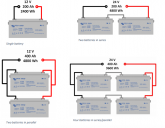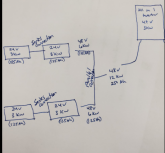dawgleader1
New Member
- Joined
- Mar 9, 2020
- Messages
- 19
Hey all, I'll preface by saying that I'm brand new to this solar thing and came across this forum via Will Prouse on youtube. I have tried to do some reading and research but it seems the more I read, the more confused I've gotten. I have drawn up a plan and hope to get some 'good job, you're on the right track' comments or some 'you're way off base idiot, do this instead' ideas. Either way it will be hugely helpful.
So what I'm trying to do is set up a medium sized solar system that will be off-grid for a mid term power outage or could even be used in a longer term emergency situation. I'm trying to make this as easy for a newbie like myself as possible while keeping the cost as minimal as possible (yes i like to get my cake and eat it too, lol). I'll mainly be using this system as an emergency system to keep the upright freezer and our normal Samsung household frig/freezer running along with charging phones, laptops, flashlights, and using an occasional electric convenience such as a bread-maker, toaster oven, hot plate, crock pot, waffle maker, etc. We will manage our usage and disconnect certain appliances to control our usage within the 3kw of our chosen all-in-1 inverter below. My plan is to get a plug in play system like this all-in-one 48v, 3Kw Growett inverter system (https://www.ebay.com/itm/USA-Supt-4...492378?hash=item48e0d1d19a:g:sxgAAOSwlD5eVqbD). I will then hook up 10 305 solar panels and connect my battery bank to this for storage. I'm looking at doing these 24v FiFePO4 Powerwall batteries from Bigbattery.com (https://bigbattery.com/product/24v-lifepo4-power-wall/ref/8/?campaign=budgetvideosystem) as suggested by Will on his site. Since these are 24v battery packs I know I need to connect 2 into series to get my 48v for the inverter system. I would like 10-12k watts of battery storage for usage overnight and in the case of bad weather/ no sun to get us through a couple days of minimal usage. If I connect 2 of the powerwall batteries in series that will get me my needed 48v for the inverter, while that doubles the voltage, does that also retain the same capacity as the 2 individual batteries. So in other words, since each battery is listed at 3kw of storage, when I connect them in series, does that mean that each set of 2 at 48v would equal 6kw of battery storage? If that is correct then I would need 4 of these powerwall batteries, with 2 series connected pairs to reach my desired 48w for the inverter and 12k watts of battery storage capacity. This is the most confusing part for me since I've talked to 2 different battery suppliers and been told 2 different things. I don't want to spend $4k on batteries and then be wrong and SOL.
Any advise, clarification, and help would be greatly appreciated. Thanks so much.
So what I'm trying to do is set up a medium sized solar system that will be off-grid for a mid term power outage or could even be used in a longer term emergency situation. I'm trying to make this as easy for a newbie like myself as possible while keeping the cost as minimal as possible (yes i like to get my cake and eat it too, lol). I'll mainly be using this system as an emergency system to keep the upright freezer and our normal Samsung household frig/freezer running along with charging phones, laptops, flashlights, and using an occasional electric convenience such as a bread-maker, toaster oven, hot plate, crock pot, waffle maker, etc. We will manage our usage and disconnect certain appliances to control our usage within the 3kw of our chosen all-in-1 inverter below. My plan is to get a plug in play system like this all-in-one 48v, 3Kw Growett inverter system (https://www.ebay.com/itm/USA-Supt-4...492378?hash=item48e0d1d19a:g:sxgAAOSwlD5eVqbD). I will then hook up 10 305 solar panels and connect my battery bank to this for storage. I'm looking at doing these 24v FiFePO4 Powerwall batteries from Bigbattery.com (https://bigbattery.com/product/24v-lifepo4-power-wall/ref/8/?campaign=budgetvideosystem) as suggested by Will on his site. Since these are 24v battery packs I know I need to connect 2 into series to get my 48v for the inverter system. I would like 10-12k watts of battery storage for usage overnight and in the case of bad weather/ no sun to get us through a couple days of minimal usage. If I connect 2 of the powerwall batteries in series that will get me my needed 48v for the inverter, while that doubles the voltage, does that also retain the same capacity as the 2 individual batteries. So in other words, since each battery is listed at 3kw of storage, when I connect them in series, does that mean that each set of 2 at 48v would equal 6kw of battery storage? If that is correct then I would need 4 of these powerwall batteries, with 2 series connected pairs to reach my desired 48w for the inverter and 12k watts of battery storage capacity. This is the most confusing part for me since I've talked to 2 different battery suppliers and been told 2 different things. I don't want to spend $4k on batteries and then be wrong and SOL.
Any advise, clarification, and help would be greatly appreciated. Thanks so much.




